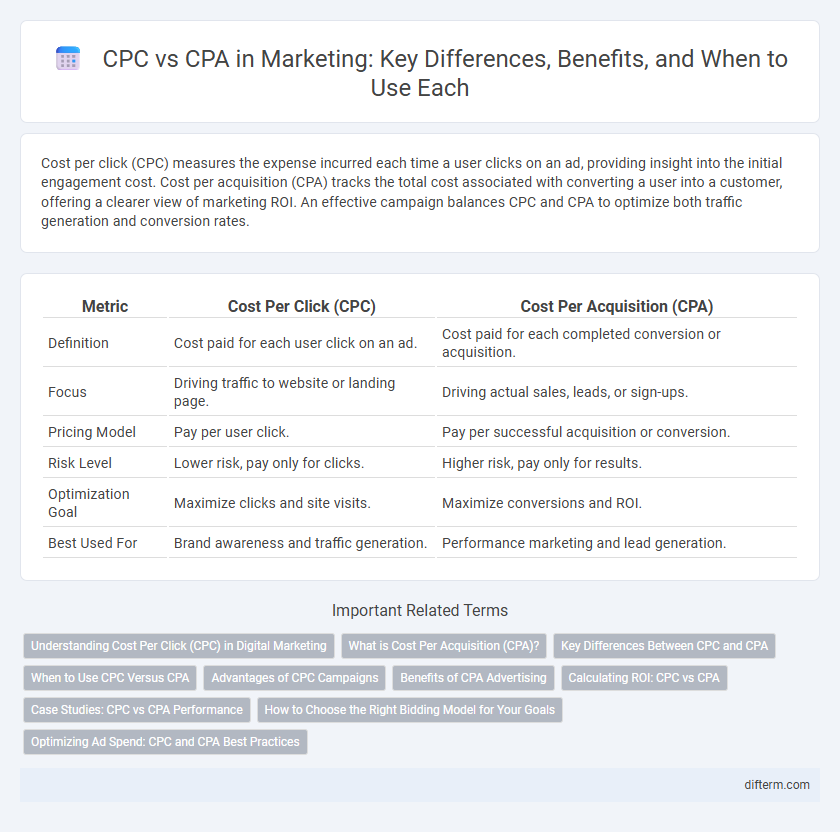Cost per click (CPC) measures the expense incurred each time a user clicks on an ad, providing insight into the initial engagement cost. Cost per acquisition (CPA) tracks the total cost associated with converting a user into a customer, offering a clearer view of marketing ROI. An effective campaign balances CPC and CPA to optimize both traffic generation and conversion rates.
Table of Comparison
| Metric | Cost Per Click (CPC) | Cost Per Acquisition (CPA) |
|---|---|---|
| Definition | Cost paid for each user click on an ad. | Cost paid for each completed conversion or acquisition. |
| Focus | Driving traffic to website or landing page. | Driving actual sales, leads, or sign-ups. |
| Pricing Model | Pay per user click. | Pay per successful acquisition or conversion. |
| Risk Level | Lower risk, pay only for clicks. | Higher risk, pay only for results. |
| Optimization Goal | Maximize clicks and site visits. | Maximize conversions and ROI. |
| Best Used For | Brand awareness and traffic generation. | Performance marketing and lead generation. |
Understanding Cost Per Click (CPC) in Digital Marketing
Cost Per Click (CPC) in digital marketing measures the expense incurred each time a user clicks on an online advertisement, serving as a crucial metric for budgeting and campaign performance analysis. CPC helps marketers evaluate the immediate cost efficiency of their ad spend by linking specific clicks to particular campaigns, keywords, or audience segments. By focusing on CPC, businesses can optimize bidding strategies and improve ad targeting to maximize traffic while controlling advertising costs before tracking long-term results like Customer Acquisition Cost (CPA).
What is Cost Per Acquisition (CPA)?
Cost Per Acquisition (CPA) is a digital marketing metric that measures the cost incurred to acquire a new customer or conversion, such as a sale or signup. Unlike Cost Per Click (CPC), which tracks the expense for each click on an ad, CPA focuses on the actual results and return on investment by attributing costs solely to successful conversions. This metric helps marketers optimize their campaigns by prioritizing quality leads and maximizing profitability rather than just increasing traffic.
Key Differences Between CPC and CPA
Cost per click (CPC) measures the expense advertisers pay each time a user clicks on an ad, focusing on driving traffic to a website or landing page. Cost per acquisition (CPA) calculates the cost incurred when a specific action, such as a sale or sign-up, is completed, emphasizing conversion efficiency. The key difference lies in CPC targeting user engagement through clicks, whereas CPA targets actual customer acquisition and overall return on investment.
When to Use CPC Versus CPA
Use Cost per Click (CPC) when the goal is to drive traffic and increase visibility, especially during early campaign stages or brand awareness efforts. Opt for Cost per Acquisition (CPA) when the focus shifts to conversion-focused campaigns where measuring specific actions like sales or sign-ups is critical. CPC is ideal for testing creative variations and keywords, while CPA aligns better with campaigns that have clear ROI and measurable performance targets.
Advantages of CPC Campaigns
CPC campaigns offer precise budget control by charging only when users click on ads, ensuring efficient spend management. They provide immediate traffic gains and valuable insight into user engagement through measurable click data. This approach supports rapid testing and optimization of ad creatives and keywords, improving campaign performance in real-time.
Benefits of CPA Advertising
Cost per acquisition (CPA) advertising offers precise budget control by charging advertisers only when a specific action, such as a sale or signup, is completed, maximizing return on investment. This model enhances campaign efficiency by focusing spending on qualified leads, reducing wasted impressions and clicks common in cost per click (CPC) campaigns. CPA advertising also provides clearer performance metrics, enabling better optimization and more accurate attribution of marketing efforts to actual conversions.
Calculating ROI: CPC vs CPA
Calculating ROI in marketing requires analyzing both Cost Per Click (CPC) and Cost Per Acquisition (CPA) metrics to determine campaign efficiency. CPC measures the expense of each ad click, useful for driving traffic, while CPA calculates the cost incurred for each customer conversion, directly reflecting revenue impact. Comparing CPC and CPA enables marketers to optimize budget allocation by focusing on channels with lower acquisition costs and higher return on ad spend (ROAS).
Case Studies: CPC vs CPA Performance
Case studies reveal that campaigns optimized for CPA often yield higher conversion rates and better return on ad spend compared to those focused solely on CPC, despite higher initial costs per click. Analyzing industry-specific data, companies in e-commerce report a 25% increase in customer acquisition efficiency when shifting budgets from CPC to CPA models. These findings suggest that CPA-centric strategies better align marketing spend with actual business outcomes, making them preferable for growth-driven advertisers.
How to Choose the Right Bidding Model for Your Goals
Choosing between cost per click (CPC) and cost per acquisition (CPA) bidding models depends on your marketing goals and campaign focus. CPC is ideal for driving website traffic and maximizing ad impressions, while CPA suits performance-driven campaigns aiming for specific conversions or sales. Analyzing campaign KPIs and customer journey stages helps determine which model delivers the best ROI and aligns with your business objectives.
Optimizing Ad Spend: CPC and CPA Best Practices
Maximizing marketing ROI requires balancing Cost per Click (CPC) and Cost per Acquisition (CPA) through data-driven budget allocation and continuous performance monitoring. Employing targeted keyword strategies reduces unnecessary CPC expenses while refining ad creatives and landing pages improves CPA efficiency by increasing conversion rates. Leveraging automated bidding algorithms optimizes spend distribution, ensuring every dollar invested aligns with campaign goals and drives profitable customer acquisition.
Cost per click (CPC) vs cost per acquisition (CPA) Infographic

 difterm.com
difterm.com